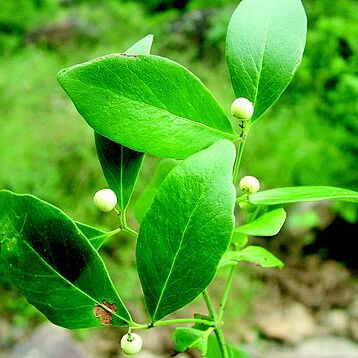Trees, to 15 m tall, sometimes shrubs; branchlets subterete or obscurely 4-angled. Petiole short, 2-5 mm; leaf blade ovate to obovate-oblong, rarely suborbicular, 3-8 × 1.5-5.2 cm, papery, base cuneate, margin entire, sometimes slightly recurved, apex obtuse, acute, rarely acuminate, very rarely retuse; veins 5 or 6 pairs, thin and obvious. Cymes of 1 or 2 branches, few flowered; peduncle very short, 2-3 mm; pedicel 1-2 mm. Flowers green; calyx lobes rounded or subreniform, ca. 0.5 × 0.75-1 mm; petals elliptic or broadly ovate, 1.25-1.5 × ca. 1 mm, reflexed at anthesis, obtuse or slightly acute. Disk margin slightly crenate. Stamens attached just abaxially on disk margin; filament subulate, fleshy, slightly flattened; anther slightly ovoid. Ovary adnate to disk at base; style very short; stigma capitate. Nut ellipsoid or sometimes slightly obovoid, 5-7 × 4-5 mm. Seed sustained by persistent floral parts. Fl. May-Dec, fr. Jul-Jan.
Shrub or tree to 15 m; branchlets glabrous. Leaves ovate, elliptic or obovate, obtuse to acuminate, rarely retuse, entire, chartaceous, glabrous; lamina mostly 2.5-6 cm long and 1-4 cm wide; base cuneate or decurrent; secondary veins 4-7 pairs; petiole 2-5 mm long. Cymes of 1-several flowers; pedicels 2-3.5 mm long. Sepals rounded, 0.2-0.4 mm long. Petals elliptic or broadly ovate, 1.2-1.5 mm long, reflexed at anthesis. Staminal filaments 0.7-0.9 mm long. Disc fleshy, cupular, crenate, c. 1.8 mm diam. Pistil urceolate; style very short; stigma cushion-shaped. Fruit ellipsoidal or obovoid, 5-7 mm long, pale yellow.


